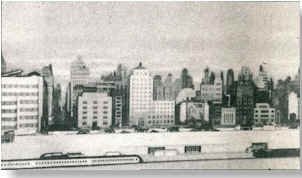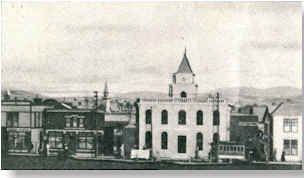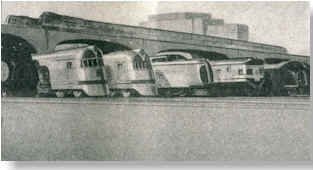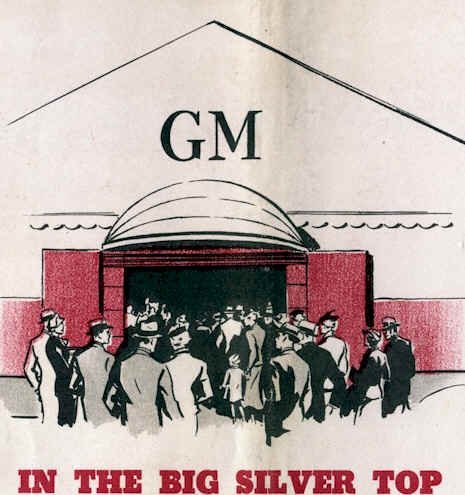1936-38 Parade of Progress Exhibits
You will find comfortable seats for 500 people at one time. The gleaming metal finish of this great sixty by eighty foot tent shuts out light and enables motion pictures to be shown in the daytime. By all means, see the feature picture, "Progress on Parade," the story of industrial advancement, told by Edwin C. Hill, Lowell Thomas, John S. Young, and John B. Kennedy.
Here also you will see modern marvels of science -- liquid light -- music on a light beam -- how a voice looks in sound waves -- water boiling, an egg frying on a cold stove -- frozen motion -- the magic eye -- and other scientific phenomena which modern industry puts to work in the solution of its problems that it may better serve you.
It's really fun to keep your own little house these days, if you have such an inviting little kitchen as that set up in the "Parade of Progress."
Stainless steel -- clean and bright and decorative. Stove, sink and table -- all modern -- spotless and sparkling. Built-in cupboards and closets -- one for the Delco vacuum cleaner and Delco electric iron and ironing board -- all lessening the housekeeper's toil. Concealed forced ventilation. A Frigidaire, of course, within easy reach. Walls of French gray, brown and soft yellow. Brown linoleum, inlaid with yellow, on the floor.
Poor Mother, as you'll see in space adjoining, had nothing like that at the turn of the century. She, dear soul, had to put up with a coal stove, an old ice box, a cast iron sink, and an oil lamp. Housework then was a chore indeed. Research and science had not yet been put to work in industry. They needed the resources of large public minded institutions. So modern industry takes its place in the march of progress among the great benefactors of womankind.
The moving research exhibits that proved most popular at the Chicago World's Fair have been collected for this "circus of science" and to them new wonders have been added.
There are stroboscopes (Left), an oscillograph, "electric eyes," a neon crater tube, a carbon stack indicator, an induction furnace, a knock-testing motor.
The stroboscopes flicker their neon lights with incredible speed and fast-moving machinery appears to stand stark still! Strobocopes are used in industry to study ways of perfecting high-speed mechanical devices, such as gears, springs, and crankshafts.
At the "General Motors Parade of Progress," a view into a running gasoline motor is shown to the public for the first time. You look through a quartz window and see the four cycles carried out -- intake, compression, explosion, and exhaust, first with ordinary gasoline, then with ethyl. You can readily detect which has the more "knock."
Music is transmitted on a light beam by means of an "electric eye," a photo-electric cell (Left). A record turns here and activates light from a neon crater tube. That varying light travels across the room and falls on the photo-electric cell which operates the loud speaker.
The carbon stock indicator measures pressures or distances as small as a millionth of an inch. One is attached to a section of a standard railway rail. You press the rail gently and the indicator does the rest. Put your warm hand on the rail and indicator will record the expansion of the steel." This device is used in industries where extremely accurate measurements are necessary.
Though cool to the touch, the induction furnace will boil water in a teakettle on its surface. It will flash sparks and make aluminum rings jump into the air. The secret is quite simple, as explained in the exposition truck where it is operated.
Scientists use the oscillograph for studying body squeaks and exhaust noises so that future automobiles may be still quieter.
Sound of any kind goes in here, goes 'round and 'round, and comes out here but when it comes out, from an oscillograph, it is no longer sound, but a waving streak of light (Below).
Until the 20th Century, progress in most forms of transportation was slow, very slow.
First, man walked, then he rode a beast, then he let the beast pull him on skids, then he invented the wheel. In time came the steam engine, later the internal combustion engine which has made possible the automobile, the airplane, and now the new streamlined trains.
Back in 1900, there were a few "horseless carriages," but good old Dobbin still pulled the street car and the "bicycle built for two" was really the smart thing to ride. In the "General Motors Parade of Progress" dioramas show animated street scenes of 1900 and 1936, each with its typical vehicles. A mural painting illustrates the Diesel powered trains one of the most recent transportation developments made possible by the research facilities of present day industry.



*Please note: the text on these pages is written in the present tense as for the 1936-38 Parade of Progress. Much of it is copied from advertising from the period.


![36ex2p6[1].jpg](https://images.squarespace-cdn.com/content/v1/5fd1021b74030f45cefbe3b7/1678367699076-MDIXM5F44MVLLJ8ZSJGV/36ex2p6%5B1%5D.jpg)
![36ex2p7[1].jpg](https://images.squarespace-cdn.com/content/v1/5fd1021b74030f45cefbe3b7/1678367715300-SQLQ1DEVQ5OQW082DAVO/36ex2p7%5B1%5D.jpg)



